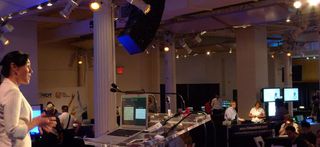Midori Connolly
“So, Stager of Business Events… tell me, what was it that inspired you to become an expert in adult learning? Was it your passion for andragogy? Was it your expertise in designing the adult learning environment?”
Ok, it’s doubtful that anyone ever asked you these questions. But have you ever truly stopped to consider the impact of our technology and how adults learn? If you provide technological support to meetings, conferences and other events where adults are expected to learn new information, then you would be wise to more clearly understand the impact of the learning environment on an adult learner.

Now that I have your interest (job security is always a great hook), here are a few considerations on how adults approach learning, and how our technology can support these needs. Adult learners are territorial and have personal space needs. They are self-directed and learn best by doing. Studies show that they are psychologically uncomfortable in traditional classroom settings that emphasize the distance and inequality between teacher and student. They have multiple learning styles, including tactical, visual and auditory.
While we can’t always control how content is formatted or how a program is designed we can provide guidance on the environment that suits the adult. Slamming hundreds of attendees cheek to cheek in a dark room for two days is not uncommon. Imagine what this does to the adult learner who is more likely to be influenced by their surroundings than children, and whose motivation may be increased through adequate space, appealing decoration, and useable furnishings. Start with the amount of gadgets and devices they bring to an event. It is almost absurd to even consider theatre style seating anymore– we need room to tap tap tap at a keyboard! And think of how many times you’ve walked into a room and seen 75% of the attendees crowded into 30% of the space. At the back, of course. Could we assist with more creative room design that uses screens in multiple locations, or suggest solutions that deliver visual content at the table, putting the teacher at the center of the room? Shifting from a “sociofugal” design to “sociopetal” is not only a way to engage adults, but is also a natural reflection of the movement towards more informal office space, such as creating huddle spaces and pop-up meeting spaces.
In addition to space design, we can always use our knowledge of sound, visuals and lighting to stimulate the absorption and retention of information. For auditory learners, suggest that you provide audio recordings, as this is more effective than note taking for their learning style. Provide table mics or sound-enabled Audience Response Systems to most effectively distribute sound and permit these learners to share and absorb knowledge. Visual learners are extremely susceptible to poor graphics, so lend your expertise in solid PowerPoint design and suggest animations and movement in visuals to enhance learning. Always ensure clear sight lines to the speakers and perhaps suggest inexpensive IMAG in breakout rooms. Perhaps small interactive whiteboard applications at tables would also be useful. Finally, for tactile, or kinesthetic learners, give them room to move around. Play music to support their study/learning. Perhaps provide iPads or kiosks around a room where they can take notes or doodle, or place lecterns at the perimeter of the room, where they can perch their own devices and take notes while standing up.
If we begin to explore the sensitivity and needs of the adult learner when it comes to AudioVisual support, we are in the ideal position to positively influence the outcomes. With the current emphasis on demonstrating ROI for meetings and events we must be creative in showing how we can be a net gain for our clients’ investments in live event technology.










